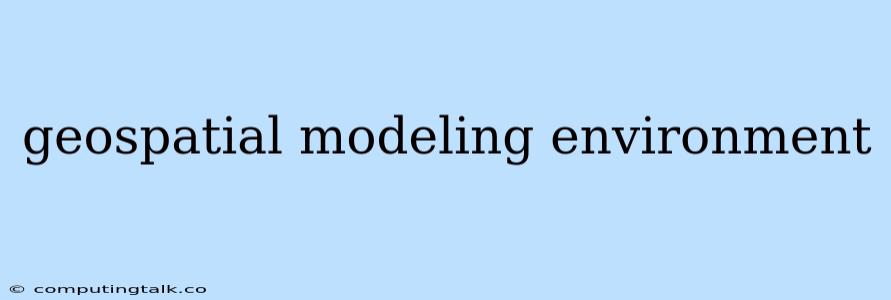A geospatial modeling environment is a powerful tool that allows users to analyze and visualize spatial data. It provides a platform for creating, editing, and managing geospatial models. These models can be used to understand complex spatial relationships, predict future trends, and make informed decisions about resource management, urban planning, and environmental protection.
What is a Geospatial Modeling Environment?
A geospatial modeling environment is a software platform that integrates various tools and techniques for spatial analysis. It allows users to:
- Import and process geospatial data: This includes data from various sources like Geographic Information Systems (GIS), remote sensing, and field surveys.
- Create and edit geospatial models: Users can define relationships between spatial data and use them to simulate real-world phenomena.
- Analyze and visualize spatial relationships: The environment provides tools to analyze spatial patterns, identify trends, and visualize results on maps and charts.
- Develop and implement decision support systems: The models created in a geospatial modeling environment can be used to support decision-making in various fields.
Benefits of Using a Geospatial Modeling Environment
There are numerous benefits to using a geospatial modeling environment:
- Improved Understanding: Geospatial models help users visualize complex spatial relationships and gain a deeper understanding of real-world phenomena.
- Enhanced Decision-Making: The models can help users make more informed decisions by providing insights into potential outcomes and risks.
- Increased Efficiency: By automating tasks and integrating data from different sources, a geospatial modeling environment can streamline the analysis process.
- Cost Savings: Geospatial models can reduce the need for expensive and time-consuming field studies.
- Better Communication: Visualizations and reports created in a geospatial modeling environment can help users communicate findings more effectively.
Key Features of a Geospatial Modeling Environment
A good geospatial modeling environment should offer the following features:
- Data Management Capabilities: The environment should allow users to import, organize, and manage spatial data from multiple sources.
- Modeling Tools: It should include a wide range of tools for creating, editing, and running spatial models.
- Spatial Analysis Functions: The environment should provide tools for analyzing spatial patterns, relationships, and trends.
- Visualization Tools: Users should be able to visualize data and model outputs on maps, charts, and other graphical representations.
- Scripting and Programming Capabilities: The environment should allow users to automate tasks and customize models using scripting languages.
- Collaboration Features: The environment should enable users to share models, data, and results with colleagues.
Choosing the Right Geospatial Modeling Environment
Choosing the right geospatial modeling environment depends on your specific needs and requirements. Consider the following factors:
- Data Types: What types of spatial data will you be working with?
- Modeling Needs: What types of geospatial models do you need to create?
- Software Compatibility: Is the environment compatible with other software you use?
- User Interface: Is the user interface intuitive and easy to learn?
- Cost: What is the cost of the software and its licensing?
Examples of Geospatial Modeling Environments
There are several popular geospatial modeling environments available on the market, including:
- ArcGIS: A comprehensive geospatial modeling environment developed by Esri. It offers a wide range of features for data management, modeling, analysis, and visualization.
- GRASS GIS: A free and open-source geospatial modeling environment that offers powerful capabilities for spatial data analysis and modeling.
- QGIS: Another free and open-source geospatial modeling environment that is gaining popularity due to its user-friendly interface and extensive plugin library.
Applications of Geospatial Modeling Environments
Geospatial modeling environments are used in a wide range of applications, including:
- Environmental Management: Modeling the spread of pollutants, predicting natural hazards, and managing natural resources.
- Urban Planning: Planning transportation systems, designing infrastructure, and analyzing urban growth patterns.
- Agriculture: Predicting crop yields, optimizing irrigation, and managing farmlands.
- Public Health: Analyzing disease outbreaks, identifying risk factors, and designing public health campaigns.
- Emergency Response: Simulating natural disasters, planning evacuation routes, and coordinating rescue efforts.
Conclusion
A geospatial modeling environment is an essential tool for anyone working with spatial data. It provides a comprehensive platform for analyzing and visualizing spatial relationships, making informed decisions, and addressing complex spatial challenges. As spatial data becomes more abundant and accessible, the use of geospatial modeling environments is expected to grow even further in the future.
